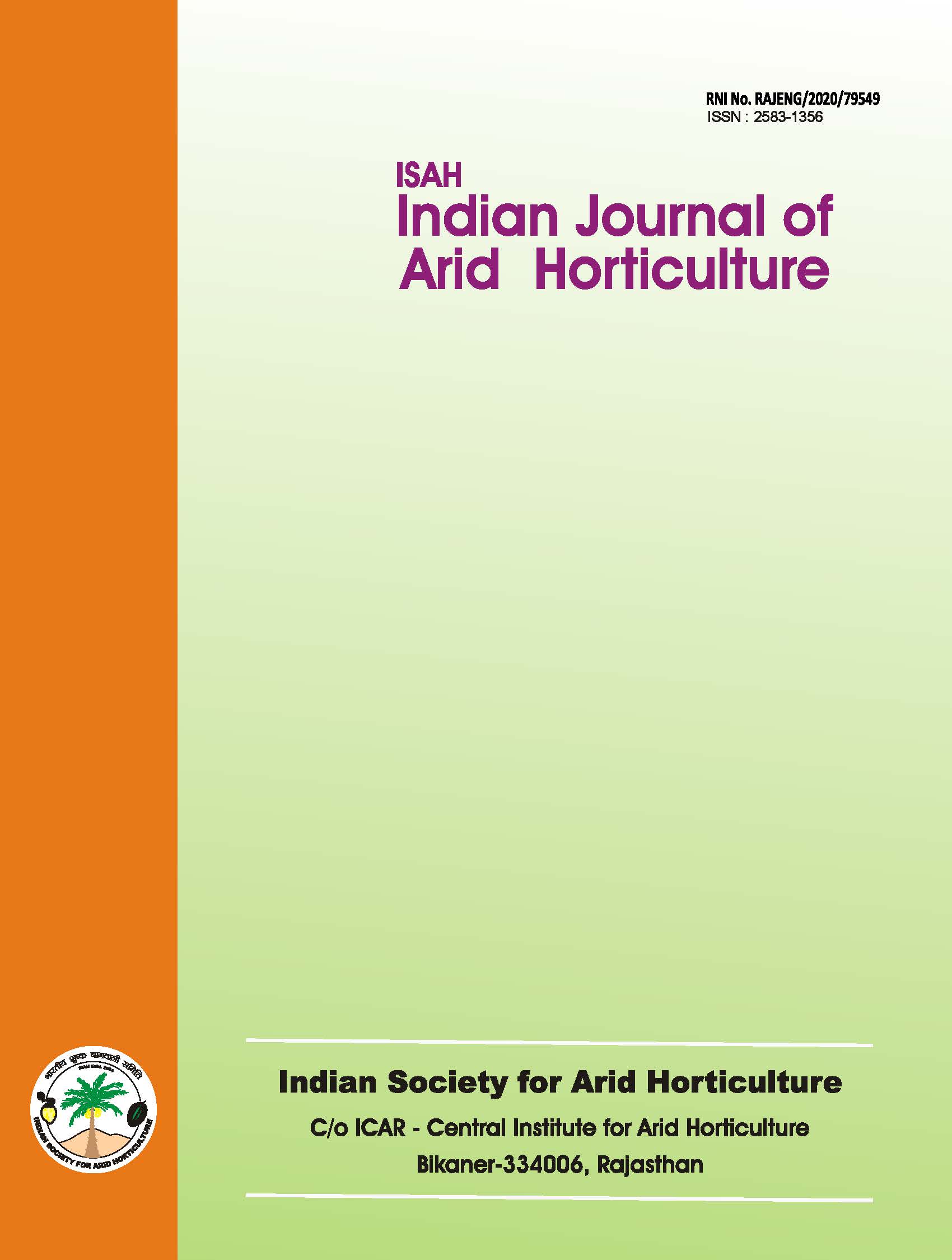Response of okra [Abelmoschus esculentus (L.) Moench.] to weed management under fertility levels in north Gujarat conditions
Keywords:
Okra, weed management, pre-emergence, weedicide, North GujaratAbstract
A field experiment was carried out during summer season at Regional Research Station, S DAU, Sardarkrushinagar to find out the suitable weed management practices for Okra cultivation in Gujarat. The highest green fruit yield (96.48 q ha') was recorded under the treatment of hand weeding at 20, 40 and 60 days after sowing i.e., Weed free (W) and it was at par with Pre-emergence application of Pendimethalin @ 1.0 kg a.i./ha (Blanket application) + Hand Weeding at 40 DAS (W,) and Hand weeding at 20 and 40 DAS (W). The highest plant height, number leaves per plant, number of branches per plant, stem girth and number of nodes per main stem was recorded with application of 100 per cent recommended dose of fertilizers i.e., 150:50:50 N, P,O, and K,O kg/ha. Monocot, dicot, sedge and total weeds population at 20 DAS were found significantly lowest under treatment (W) i.e., pre-emergence application of pendimethalin@ 1.0 kg a.i./ha (W.) + Hand Weeding at 40 DAS (3.20, 2.75, 2.99 and 5.07 per m2, respectively) as compare to rest of treatments but it was found at par with treatment (W) i.e., W, + interculturing at 20 DAS (3.22, 2.77, 3.04 and 5.13 per m2), W, i.e., W, + interculturing at 40 DAS (3.26, 2.84, 3.05 and 5.20 per m2) and W, i.e.. pre-emergence application of pendimethalin @ 1.0 kg a.i./ha (3.27, 2.85, 3.06 and 5.21 per m2), respectively. The highest Benefit: Cost Ratio (4.04) was noted with weed free treatment (i.e., Hand Weeding at 20, 40 and 60 DAS) (W,), followed by W, i.e., Hand weeding at 20 and 40 DAS (3.90) and W, i.e., Pre-emergence application of Pendimethalin@ 1.0 kg a.i./ha (Blanket application) + Hand Weeding at 40 DAS (3.77). Application of 100 per cent recommended dose of NPK fertilizers proved beneficial (BCR of Rs.3.15) over 75 per cent of the recommended dose. The results revealed that higher summer okra green fruit yield of cv. Parbhani Kranti can be acheived by adopting hand weeding at 20, 40 and 60 DAS or hand weeding at 20 and 40 DAS or with pre-emergence application of pendimethalin @ 1.00 kg a.i./ha (Blanket application) coupled with hand weeding at 40 DAS.Downloads
References
Adejonwo, K. W.; Ahmed, M. K.; Lagoke, B. T. O.; Karikari, S. K. (1991). Chemical weed control in irrigated okra in the Nigeria, Sudan Savanna Zone. Tropical Pest Management, 39(1): 91-95.
Ambare, T. P.; Gonge, V. S.; Rewatkar, S. S.; Mohariya, Anjali, and Shelke, T. S. (2005). Influence of nitrogen levels and varieties on yield and quality of okra. Crop Research, 30(1): 80-82.
Aykroyd (1941). Health Bulletin No. 23. Pub. Nutrition Research Laboratory, Koonoor.
Kumar, A. and Choudhary, B. M. (2004). Weed management of okra (Abelmoschus esculentus (L.) Moench). Orissa Horticultural Society, 50.
Patel, R. B.; Patel, B. D.; Meisuriya, M. I.; and Patel, V. J. (2004). Effect of methods of herbicide application on weeds and okra (Abelmoschus esculentus (L.) Moench). Indian Journal of Weed Science, 36(3-4): 304-305.
Saimbhi, M. S.; Gill, B. S.; and Dhillon, N. P. S. (1991). Response of okra to various levels of nitrogen and phosphorus. Journal of Research Punjab Agricultural University, 28(2): 203-205.
Singh, S. V. and Batra, B. R. (1994). Weed control studies in relation to nitrogen doses in okra. Haryana Journal of Horticultural Science, 23(2): 137-140.
Tiwari, S. K.; Singh, B. P.; and Bramachari, V. S. (1985). Orissa Journal of Horticulture, 32(1): 73-74.
Meena, M. L.; Sanjav, K.; and Dixit, S. K. (2008). Effect of bio-fertilizers and nitrogen levels on flowering, fruiting yield and yield attributes of okra (Abelmoschus esculentus (L.) Moench). Pesticides, 19(6): 70-72.

